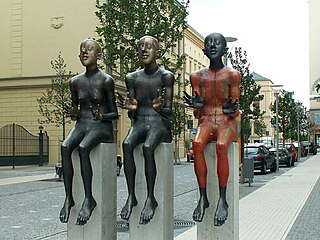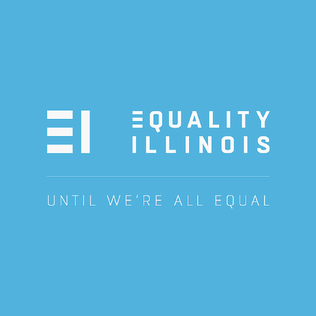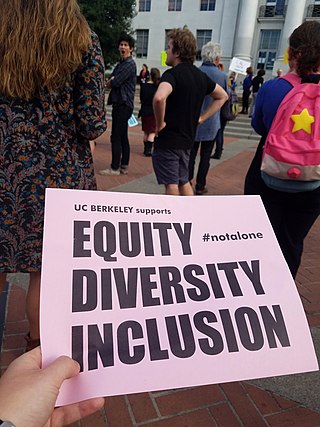
Discrimination is the process of making unfair or prejudicial distinctions between people based on the groups, classes, or other categories to which they belong or are perceived to belong, such as race, gender, age, religion, physical attractiveness or sexual orientation. Discrimination typically leads to groups being unfairly treated on the basis of perceived statuses based on ethnic, racial, gender or religious categories. It involves depriving members of one group of opportunities or privileges that are available to members of another group.

Justice, in its broadest sense, is the concept that individuals are to be treated in a manner that is equitable and fair.
Affirmative action refers to a set of policies and practices within a government or organization seeking to benefit marginalized groups. Historically and internationally, support for affirmative action has been justified by the idea that it may help with bridging inequalities in employment and pay, increasing access to education, and promoting diversity, social equity and redressing alleged wrongs, harms, or hindrances, also called substantive equality.

Toleration is when one allows, permits, or accepts an action, idea, object, or person that one dislikes or disagrees with.

A glass ceiling is a metaphor usually applied to people of marginalized genders, used to represent an invisible barrier that prevents an oppressed demographic from rising beyond a certain level in a hierarchy. No matter how invisible the glass ceiling is expressed, it is actually an obstacle difficult to overcome. The metaphor was first used by feminists in reference to barriers in the careers of high-achieving women. It was coined by Marilyn Loden during a speech in 1978.

Equity, or economic equality, is the concept or idea of fairness in economics, particularly in regard to taxation or welfare economics. More specifically, it may refer to a movement that strives to provide equal life chances regardless of identity, to provide all citizens with a basic and equal minimum of income, goods, and services or to increase funds and commitment for redistribution.
Chapter Two of the Constitution of South Africa contains the Bill of Rights, a human rights charter that protects the civil, political and socio-economic rights of all people in South Africa. The rights in the Bill apply to all law, including the common law, and bind all branches of the government, including the national executive, Parliament, the judiciary, provincial governments, and municipal councils. Some provisions, such as those prohibiting unfair discrimination, also apply to the actions of private persons.
Diversity, in a business context, is hiring and promoting employees from a variety of different backgrounds and identities. Those characteristics may include various legally protected groups, such as people of different religions or races, or backgrounds that are not legally protected, such as people from different social classes or educational levels. A business or group with people from a variety of backgrounds is called diverse; a business or group with people who are very similar to each other is not diverse.
Employment equity, as defined in federal Canadian law by the Employment Equity Act, requires federal jurisdiction employers to engage in proactive employment practices to increase the representation of four designated groups: women, people with disabilities, visible minorities, and Indigenous peoples. The act states that "employment equity means more than treating persons the same way but also requires special measures and the accommodation of differences".
The Declaration of Human Duties and Responsibilities (DHDR) was written for reinforcing the implementation of human rights under the auspices of the UNESCO and the interest of the Office of the United Nations High Commissioner for Human Rights and was proclaimed in 1998 "to commemorate the 50th anniversary of the Universal Declaration of Human Rights (UDHR)" in the city of Valencia. Therefore, it is also known as the Valencia Declaration.
Christian privilege is a social advantage bestowed upon Christians in any historically Christian society. This arises out of the presumption that Christian belief is a social norm, that leads to the marginalization of the nonreligious and members of other religions through institutional religious discrimination or religious persecution. Christian privilege can also lead to the neglect of outsiders' cultural heritage and religious practices.
The Outies, formally known as the Out & Equal Workplace Awards, is an annual awards gala hosted by Out & Equal Workplace Advocates. The Outies honor individuals and organizations that are leaders in advancing equality for lesbian, gay, bisexual, and transgender (LGBT) employees in America's workplaces. Through these awards, Out & Equal provides the business and LGBT communities with examples of innovative approaches and proven successes to help create safe and equitable workplaces. The awards are presented annually at the Out & Equal Workplace Summit, a nationwide conference addressing LGBT issues in the workplace.
Compensation and benefits (C&B) is a sub-discipline of human resources, focused on employee compensation and benefits policy-making. While compensation and benefits are tangible, there are intangible rewards such as recognition, work-life and development. Combined, these are referred to as total rewards. The term "compensation and benefits" refers to the discipline as well as the rewards themselves.
Educational equity, also known as equity in education, is a measure of achievement, fairness, and opportunity in education. The study of education equity is often linked with the study of excellence and equity.
Norma Margherita Riccucci is Board of Governors Distinguished Professor of Public Administration at the School of Public Affairs and Administration at Rutgers University in Newark. She is a scholar in the field of Public Administration. An authority on issues related to social equity, affirmative action and public management, Dr. Riccucci is widely known for her work in the area of diversity management in government employment.

Historically speaking, lesbian, gay, bisexual, and transgender (LGBT) people have not been given equal treatment and rights by both governmental actions and society's general opinion. Much of the intolerance for LGBT individuals come from lack of education around the LGBT community, and contributes to the stigma that results in same-sex marriage being legal in few countries (31) and persistence of discrimination, such as in the workplace.

Equality Illinois (EI) was founded in 1991 to work towards building a better Illinois by advancing equal treatment and social justice through education, advocacy, and protection of the rights of the LGBT community.
South Africa is a secular state, with freedom of religion enshrined in the Constitution.
Executive Order 13672, signed by U.S. President Barack Obama on July 21, 2014, amended two earlier executive orders to extend protection against discrimination in hiring and employment to additional classes. It prohibited discrimination in the civilian federal workforce on the basis of gender identity and in hiring by federal contractors on the basis of both sexual orientation and gender identity.

Diversity, equity, and inclusion are organizational frameworks which seek to promote "the fair treatment and full participation of all people", particularly groups "who have historically been underrepresented or subject to discrimination" on the basis of identity or disability. These three notions together represent "three closely linked values" which organizations seek to institutionalize through DEI frameworks. Some experts say diversity and inclusion should be decoupled in some cases. Some frameworks, primarily in Britain, substitute the notion of "equity" with equality: equality, diversity, inclusion (EDI). Other variations include diversity, equity, inclusion and belonging (DEIB), justice, equity, diversity and inclusion, or diversity, equity, inclusion and access.









